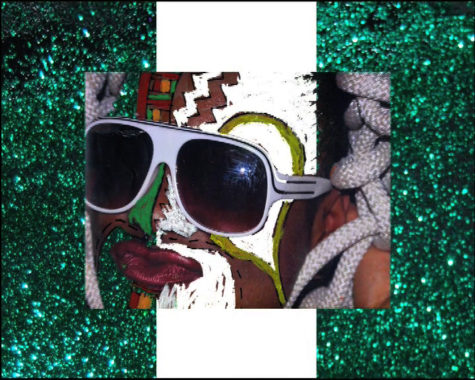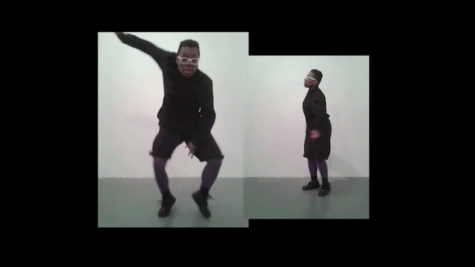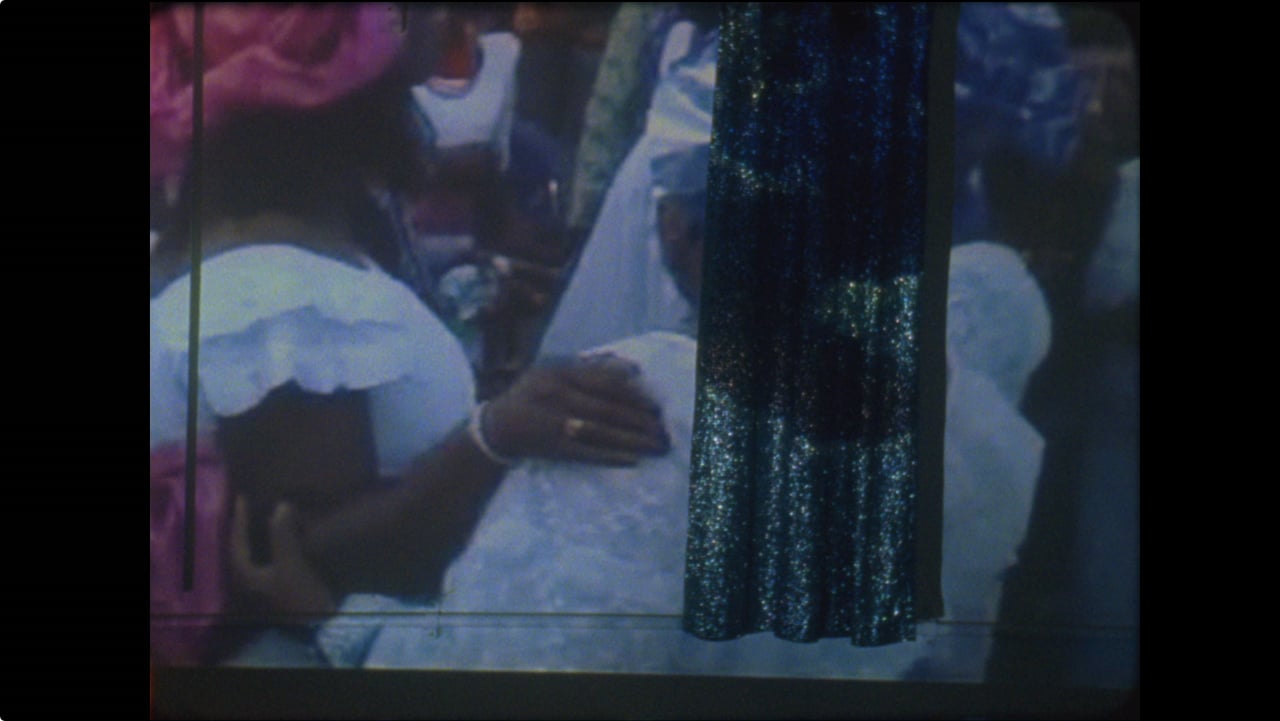I imagine that a collection of Evan Ifekoya’s films, stumbled upon in an archive for the first time, will be akin to an offering. Perhaps led to this work through their own interests, the recipient may enjoy, and be empowered by, a discovery of community with other viewers who came to this collection to study Ifekoya’s exploration of rhythm, or texture and weaving, or self-archiving, or mother tongues and pedagogy.
The Music Video ( Rhythm and Refrain )
As is recurrent across many of Ifekoya’s works[1], She Was a Full Body Speaker (2016) formulates its narrative through refrains. These repeated phrases float in and away and in again: Tomorrow I still have last night in my body… May her soul rest in perfect peace… The discoball turns like a relic. . The title refrain and other snippets recur as a cyclical mix of archival video – my favourite is of the shoulder shrugging cross-stepped march of the white-robed funeral bearers – create waves of rhythm in an extended-cut music video.
Deeply devoted to the dance floor, Ifekoya emanates that thumping sense of rhythm straight from the gut[2], live and direct. Before She Was a Full Body Speaker, Ifekoya’s longest film as of 2020, listeners and viewers bopped on humbler scales to Ojulowo (2014), another music video, which employs green screen technique to cut in and out of imagery. Earlier still is The Gender Song (2014), in a nonchalant, if not playful and satirical, tune that they wrote which could have stood alone as a cassette-release sold out of a jovial queer punk’s car boot. In its music video, Ifekoya dances along inside a quick assembled set in lo-fi digital.[3]
Catchy and lyrically well-structured, the song laid over a water-synthy, afrobeat-dancehall riddim.[4] Light-hearted beat and medium-pan dancing take in contrast with Ifekoya’s deadpan seriousness in the close-up shots. The low droning vocal delivery is in high contrast with the jubilant neon television static.
Nature/ Nurture sketch (2013) is a simple collage.[5] Whereas in the music videos previously discussed, the viewer follows fairly swift jump-cuts and returns between recurrent scenes, Nature/ Nurture sketch is comparatively paired-back. Within the screen there are two frames, lined up where the floor meets the wall and playing simultaneously.
In the left-hand frame is Ifekoya, dancing, ostensibly as nature, and on the right is also Ifekoya, also dancing, as nurture. I revel in tipping nascent readers off to Ifekoya’s talent as a selectah. The artist, who has produced and DJ’d widely under various pseudonyms[6] has worked with a wide range of womxn in electronic music. Venus X’s gutty tune ‘Renegade Berberse’ soundtracks Nature/ Nurture sketch. Later, Ifekoya sampled Elysia Crampton, whose single ‘Lake’ thumps beneath Ebi flo (2016) and its sombre tone. Evan arranges the lyrics and composes a simple refrain which could be thought of as a mantra: We are family, an observation, a lament and an expression of desire all at the same time.

Hybrid Vigor, Evan Ifekoya, 2010
Weaving on Beat (Texture and Surface)
Their use of rhythm might best be described as a form of weaving. Parts of She Was a Full Body Speaker were shot on 16mm at now-closed no.w.here[7] and melded with found footage, recorded and archived by Sandi Hughes of Liverpool’s queer nightlife. Both of those elements are collaged again with documentation of a funeral celebration in rural Nigeria. She, the PA system ’speaker’, is bedazzled. The speaker, wearing femininity, is a club’s resident burlesque performer. At the same time, She, who was a speaker, a stately elder, is regaled in fine fabric and jewellery.
The rhythms in Speaker are created through a process of weaving, whether that is through collaging and layering still images within a flowing melody[8], through utilising archival footage[9], or through re-using source elements across multiple works, for example Hybrid Vigor (2010) and Ojulowo (2014) share imagery.
Threaded together like a weave, the videos also incorporate textiles and surfaces. Ifekoya studied two years of a Textile Arts BA degree before switching to and completing their studies in Fine Art New Media from Winchester School of Art. The textile aspect of their creativity is evidenced through their attentiveness to fabrics, adornment and texture on each surface they use, which in this case, in the LUX Archive, is the image screen. In one scene in She Was a Full Body Speaker, a white cloth printed with disembodied limbs and phrases like Once situated on Wardour Street, where the Starbucks is now was screen-printed by Ifekoya, likely facilitated by textile practice in their early arts education.
Hybrid Vigor is a coarse chopped compilation mix of house, pop, hip hop and gender where images have been edited to flow across the screen at varied rhythmic paces that also depicts Ifekoya’s weaving practice [timestamp 00:56]. The glitterati Nigerian flag [timestamp 3:04] reminds me that glitter and metallic shine recur in Ifekoya’s work in many forms: the discoball, the shimmery silver curtain drape and glitter tulle are props that viewers might have seen Ifekoya use and re-use both on and off screen in performances and sculptural installations during this period (2010s).
Although I do believe that sometimes these videos do present us with characters (i.e. the Loverman that i’ll discuss later in the text), none of these personalities are in the costume. The personalities Ikefoya wears in each of these videos are not in costumes at all, but rather in threads that were current to Ifekoya’s collection of outfits.
Head to Toe: Portraiture and Self-imaging
In that way, Ifekoya’s video work can also be considered a mode of portraiture. The artist appears in almost all of their films. Them as the point of focus serves a practical benefit. In films in which the artist is also the main subject, and sometimes even the cameraperson too, the production of the work can be more spontaneous (less crew, less arduous production schedules). More relevant for Ifekoya, I think, is how their appearance in each film dictates a level of control. Manipulating the spectacle around their appearance in the work, Ifekoya exercises their agency at multiple points in the films’ production.
I imagine this tendency to appear in their own films also holds an element of self-archiving: Ifekoya never waited for a centralised institution to acknowledge them before they started documenting their practice. Little possibility exists for the artist themself to be erased in the uptake of their work into the archives. Their desire to have their work contextualised adequately is supported by their body, their positionality. Ifekoya once said ‘Making a spectacle of oneself is a political act,’[10] and I would interpret the politics of these acts – to insert their undeniable, recurrent presence, is to ensure that those who come after them see them and know them.
Ifekoya’s tendency toward self-portraiture recalls a spiritual register that many artists have explored with film and photography through self-documentation as a daily practice. Their work eschews the seriality that prefigures the strictly conceptual, and vulnerable, self-documentarians of the late 20th century.[11] However, through the use of refrain–their return to and re-use of these self-images– suggests a regular, if not strictly structured, practice of documenting their own presence. In this sense perhaps the most relevant artistic elder to would be Maud Sulter’s whose regular practice of sitting for her own photographs – though she very much did incorporate costume and period dress in her work – allows us to feel Sulter’s changing presence over the course of her life.

Nature Nurture (sketch), Evan Ifekoya, 2013
Mother: Tongues and Pedagogy.
In Nature/ nurture Sketch (2013), the dance-off between two Ifekoyas is a self-portrait of a battle waged on the ground of authenticity. On the right, if they are Nurture, dances with moves that have been taught / acquired / learned. On the left, I believe as Nature, ostensibly calls upon the artists’ natural sense of rhythm to formulate their response to the thumping track[12].
It is a blunt question: to what extent do you move in the world based on what you have learned is the right way to be? Or do you move in the world according to what is innately within you? Replace ‘move in the world’ with any sort of worldly action, whether it be dance, art practice, writing, interaction with peers and colleagues, interactions with strangers, people you have power over, people who have power over you. To what extent is your ‘dance’ innate or learned?
Ojulowo, lighthearted and satirical, ends with a mock-cooking show. This time Ifekoya walks us through a bounty ball recipe – a candy that is dark on the outside, white on the inside. In this cheeky pun, questions of a genuine, inside connection to one’s ‘Black culture’ is brought in relation to the recipe book, a tool which makes these elements, supposedly of authenticity, performable by anyone.
In She Was a Full Body Speaker, the refrain ‘no more calls in Yoruba’ suggests that those calls represented a primarily if not sole opportunity to bask in that tongue. How many hours of practice does it take to be fluent in a language? To maintain it? Ifekoya wraps their head around one of their mother tongues, Yoruba, throughout these videos (and also in their 6-hour audio epic ‘Ritual Without Belief’ shown at Gasworks in 2018), working in words and phrases with topical charge towards home, origin and culture. Evoking inheritance: knowledge, lessons, abundance of culture (and later, spirituality), the Ebi in Ebi Flo is the Yoruba for family. Ifekoya deploys the ubiquitous Sister Sledge track in the context of a few families – family of origin, but also London, queer, Black womxn artist families.[13]
Families (can) supersede the institution as primary sites of learning and nourishment for its young members. A boi is (2012), written, directed and edited by Ifekoya, playfully mocks a school-children programme with bubble-magnet letters and an animated background. On this programme, it seems that the host teaches vocabulary words and helps viewers learn the basics of a particular language. The viewer meets Ifekoya as a tv presenter, sitting with a school child in uniform giving a lesson on terms relevant to a growing sense of the possibilities of gender and sexuality.
Many Gendered Mothers of My Heart[14]
The Gender Song (2014) continues on the pedagogical thread that A boi is initiated, again addressing the basics geared toward the beginner gender-abolitionist. Produced and released in solidarity with a queer film festival whose screenings had been cancelled due to an illegal and discriminatory a ban on LGBTI events in Istanbul, The Gender Song could be implied as a pedagogical world opening for a fledgling ‘queer’ and also a theme song in support of those who tirelessly organise and campaign for a juridical legitimacy to the notion that gender is not fixed or binary.
Hybrid Vigor (2010) offers a brief history of lesbian periodicals through cover snapshots of three magazines made by and geared towards queer women. Later in the video, we meet the ‘Loverman’ that Shabba Ranks never intended, with a dandy moustache and lipstick. Ifekoya takes this gender-bending character just a tad further than Prince, Bowie or some of our other gender-bending but still virile masculine pop stars would take it. Of course, Ifekoya comes to the rave from another angle, their proprioceptor pokes through a trash bag and hangs to the left.
BBALL Curriculum (2012) visits the homoerotic undertones that can undergird sport, group recreation (dance) and the cis-straight tricky curriculum as to what circumstances are appropriate – or ‘not gay’ – to be unclothed/ vulnerable/ sensual around others. Bball Curriculum works with collage, rhythm and weaving / layering to bring together archival found footage from different twentieth century eras of group sport, punctuated by a sporty dance number featuring three slender shirtless men gyrating in basketball shorts-as-loungewear.
As early work is thought to hold seed ideas that are developed later in artist’s practice, I see these three videos as seeds to what Ifekoya developed later in She Was a Full Body Speaker: the rhythms, the layering, and also the use of archival footage pertaining to the life of queer folks in the UK. Amongst its other aforenoted elements, She Was a Full Body Speaker samples an archive of Liverpool club culture. Like the community elder, she, London queer nightlife as it once was, is dead. The loss of connection to the homeland mirrors the loss of that storied era of queer nightlife.
Prophetic in Practice
In this video collection, moments I have termed as foreshadowing or seeds could equally be explicated as ‘prophetic’ practice. Early works hold seeds of Ifekoya’s development into an esoteric practitioner. Can you see how Okun Song, Ebi Flo and contoured thoughts (2019) could be used as meditations, video-talismans for those organising for movements of gender-abolition, de-centring European spectrums of authenticity and exoticism? Dismantling the need to move to rhythms outside of one’s ‘Nature’, Ifekoya now implores us to ‘practice stillness as a matter of urgency’[15]. Ifekoya invites, through song, a moment of self-reflection and resilience-building for the many families who have been worn down by resistance efforts.
Appreciate the invigoration of a good bassline and be guided through their shifts in focus and understanding in their recent film, contoured thoughts. Still photographs[16] are collaged here on top of footage shot on location in Iceland by long-time collaborator Kat Perlak. The candle that punctuates the video demarcates the cinema space as open for a ritual. contoured thoughts is a lesson in reconnecting with our senses of oneness with a community, as group solidarity can melt away the obstacles that keep us from feeling safe, whole and in flow: “all resistance is, is for a moment feeling singular instead of plural”[17].
I implore you, dear future reader, to acknowledge the seeds of this healing-pedagogy in their earlier videos. contoured thoughts shows us where Ifekoya’s video works might be going, what sort of practices they might be manifesting (at time of writing 2020) that are aligned with the artist’s focus on self-reflection, replenishment and inner work. Looking back, from today, I would describe Evan Ifekoya’s films as an element of – or evidence of – a wider spiritual practice that includes: sound, music, performance, textiles, drawing, DJing, activism, teaching, archiving.
It is my opinion that work by Black british artists is underserved and inaccurately catalogued when its interpretation and criticism is grossly overdetermined – even scaffolded – by a critics’ limited if not growing understanding of the sociological truths, and politics, which the work digests. Do not fail Ifekoya’s video collection in your future interpretations based on what you find here. Thus, I hesitate to lead nascent readers directly to Ifekoya’s work outside of scope of the screen and in the ‘social realm’… but could you take the film practice in the context of their other interventions into both the social world and their own inner world, and then see this growing body of work as evidence of what a person, devoted to personal and political freedom, would make in video format. In the form of a resource guide, below are some other formats that you, dear nascent reader, can look at to compliment your analysis. Best of luck beginning your in-depth search.
[1]see ‘Review: Evan Ifekoya, ‘Ritual Without Belief’’, Taylor Le Melle in Flash Art 322
[2]https://mozaic.theassemblage.com/the-solar-plexus-chakra/
[3]Salomé Voegelin summarised this well in her analysis of The Gender Song included in her book The Political Possibility of Sound: ‘…video editing techniques and effects that are no doubt digital but in their undisguised simplicity bring an analogue sense to the work.’ P 124 (Voegelin, 2018)
[4]It is the “Go Go Club Riddim”, produced in 2013.
[5]This work was included in Christine Eyene’s Exhibition: Curators’ Series #8. All Of Us Have A Sense Of Rhythm (5 June – 1 Aug 2015) at David Roberts Art Foundation, London.
[6]For pseudonyms see: Sticky Black, Government DJ and Oceanic Sage
[7]https://twitter.com/nowherelondon for an archive of their activities. In 2018, no.w.here shut and transferred its assets to not/nowhere, an artists’ workers cooperative
[8]Also see contoured thoughts (2019)
[9]Example: She Was a Full Body Speaker (2016), BBall Cirrciulum (2012)
[10]https://twitter.com/evan_ife/status/619958524722978820
[11]See: Adrian Piper Food for the Spirit 1971, 14 silver gelatin self-portraits taken during an intense spiritually turbulent time of study
[12]And yes – what is the difference between nature and nurturei? nature is perhaps more bombastic- but this is my projection.
[13]That Ifekoya literally merges with the forest in Ebi Flo foreshadows their growing ‘familial’ connection to the nature-allied spiritual traditions of both Buddhism and Yoruba religion.
[14]Sampled from Dana Ward, ‘A Kentucky of Mothers’ 2014
[15]https://www.instagram.com/evan_ife/p/BpAdaAWhIgr/?hl=en
[16]Still Photographs, Andie Macario
[17]From contoured thoughts
Taylor Le Melle writes, organises and produces objects. With Jennifer Martin and Rhea Storr, they run not/nowhere an artists’ workers cooperative focusing on analogue film and its related technologies.
Resource Guide:
Organisation and Facilitation
Collective Creativity, a long-term collaboration with artists Raju Rage, Raisa Kabir and Rudy Loewe
https://qtipoccollectivecreativity.tumblr.com/
https://www.tandfonline.com/doi/abs/10.1080/09574042.2019.1658510?af=R&journalCode=rwcr20
Fundraising for Mutual Aid:
Qtibipoc hardship fund
This emergency relief and hardship fund has been set up to provide short term support to Queer, Trans and Intersex, Black, Indigenous, People of Color (QTIBIPOC) currently living in the UK who are affected by the outbreak and ongoing shutdown caused by Covid-19.
https://www.gofundme.com/f/nepjh-uk-qtibipoc-emergency-relief-amp-hardship-fund
Support of Goldsmiths Anti-racist Occupation and subsequent withdrawal of Labour from Goldsmiths University:
https://goldsmithsucu.org/2020/06/16/gucu-statement-of-support-for-evan-ifekoya/
https://twitter.com/evan_ife/status/1272456549215211521
Studying and Archiving Black womxn artists and archives:
Evan Ifekoya on Lubaina Himid
Evan Ifekoya on Lubaina Himid
Evan Ikekoya with Ajamu X and Rene Matic
Healing exercises for Limitless Potential with Hannah Catherine Jones:
https://soundcloud.com/evanifekoya/healing-exercises-for-limitless-potential-help






